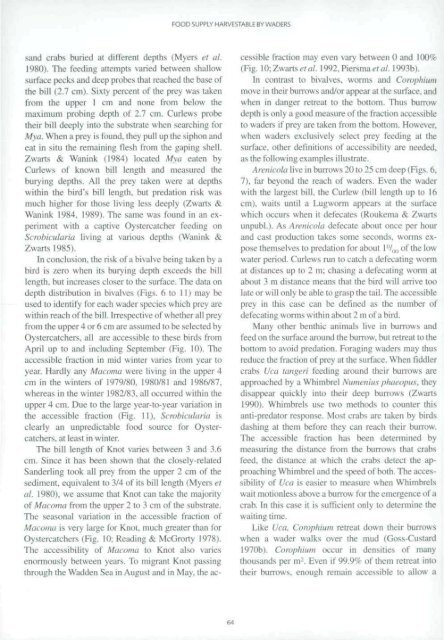waders and their estuarine food supplies - Vlaams Instituut voor de ...
waders and their estuarine food supplies - Vlaams Instituut voor de ...
waders and their estuarine food supplies - Vlaams Instituut voor de ...
You also want an ePaper? Increase the reach of your titles
YUMPU automatically turns print PDFs into web optimized ePapers that Google loves.
s<strong>and</strong> crabs buried at different <strong>de</strong>pths (Myers el al.<br />
1980). The feeding attempts varied between shallow<br />
surface pecks <strong>and</strong> <strong>de</strong>ep probes that reached the base of<br />
the bill (2.7 cm). Sixty percent of the prey was taken<br />
from the upper 1 cm <strong>and</strong> none from below the<br />
maximum probing <strong>de</strong>pth of 2.7 cm. Curlews probe<br />
<strong>their</strong> bill <strong>de</strong>eply into the substrate when searching for<br />
Mya. When a prey is found, they pull up the siphon <strong>and</strong><br />
eat in situ the remaining llesh from the gaping shell.<br />
Zwarts & Wanink (1984) located Mya eaten by<br />
Curlews of known bill length <strong>and</strong> measured the<br />
burying <strong>de</strong>pths. All the prey taken were at <strong>de</strong>pths<br />
within the bird's bill length, but predation risk was<br />
much higher for those living less <strong>de</strong>eply (Zwarts &<br />
Wanink 1984. 1989). The same was found in an experiment<br />
with a captive Oystercatcher feeding on<br />
Scrobicularia living at various <strong>de</strong>pths (Wanink &<br />
Zwarts 1985).<br />
In conclusion, the risk of a bivalve being taken by a<br />
bird is zero when its burying <strong>de</strong>pth exceeds the bill<br />
length, hut increases closer to the surface. The data on<br />
<strong>de</strong>pth distribution in bivalves (Figs, o to II) may be<br />
used to i<strong>de</strong>ntify for each wa<strong>de</strong>r species which prey are<br />
within reach of Ihe bill, [irrespective of whether all prey<br />
from the upper 4 or 6 cm are assumed to be selected by<br />
Oystercatchers, all are accessible to these birds from<br />
April up to <strong>and</strong> including September (Fig. 10). The<br />
accessible fraction in mid winter vanes Irom year lo<br />
year. Hardly any Macoma were living in the upper 4<br />
cm in the winters of 1979/80. 1980/81 <strong>and</strong> 1986/87.<br />
whereas in the winter 1982/83. all occurred within ihe<br />
upper 4 cm. Due to the large year-to-year variation in<br />
the accessible fraction (Fig. II), Scrobicularia is<br />
clearly an unpredictable <strong>food</strong> source for Oystercatchers.<br />
at least in winter.<br />
The bill length of Knot varies between 3 <strong>and</strong> 3.6<br />
cm. Since ii has been shown that the closely-related<br />
S<strong>and</strong>erling took all prey from the upper 2 cm of the<br />
sediment, equivalent to 3/4 of its bill length (Myers et<br />
al. 1980). we assume that Knot can take the majority<br />
of Macoma from the upper 2 to 3 cm of the substrate.<br />
The seasonal variation in ihe accessible fraction of<br />
Macoma is very large for Knot, much greater than for<br />
Oystercatchers (Fig. 10: Reading & McGrorty 1978).<br />
The accessibility of Macoma to Knot also varies<br />
enormously between years. To migrant Knot passing<br />
through the Wad<strong>de</strong>n Sea in August <strong>and</strong> in May. the ac<br />
FOOD SUPPLY HARVESTABLE BY WADERS<br />
64<br />
cessible fraction may even vary between 0 <strong>and</strong> lOO'/r<br />
(Fig. 10: Zwarts etal. 1992. Piersma et al. 1993b).<br />
In contrast to bivalves, worms <strong>and</strong> Corophium<br />
move in <strong>their</strong> burrows <strong>and</strong>/or appear al the sin lace, <strong>and</strong><br />
when in danger retreat to the bottom. Thus burrow<br />
<strong>de</strong>pth is only a good measure of the fraction accessible<br />
to <strong>wa<strong>de</strong>rs</strong> if pre) are taken Irom the bottom. However,<br />
when <strong>wa<strong>de</strong>rs</strong> exclusively select prey feeding at the<br />
surface, other <strong>de</strong>finitions of accessibility are nee<strong>de</strong>d,<br />
as the following examples illustrate.<br />
Arenicola live in burrows 20 to 25 cm <strong>de</strong>ep (Figs. 6.<br />
7). far beyond the reach of <strong>wa<strong>de</strong>rs</strong>. Even the wa<strong>de</strong>r<br />
with the largest bill, the Curlew (bill length up to 16<br />
cm), waits until a Lugworm appears at the surface<br />
which occurs when il <strong>de</strong>fecates i Roukema & Zwarts<br />
unpubl.). As Arenicola <strong>de</strong>fecate about once per hour<br />
<strong>and</strong> cast production takes some seconds, worms expose<br />
themselves to predation for about 1"/,,, of the low<br />
water period. Curlews run to catch a <strong>de</strong>fecating worm<br />
at distances up to 2 m: chasing a <strong>de</strong>fecating worm at<br />
about 3 m distance means that the bird will arrive too<br />
late or will only be able lo grasp the tail. The accessible<br />
prey in this case can be <strong>de</strong>fined as the number of<br />
<strong>de</strong>fecating worms within about 2 m of a bird.<br />
Many other benthic animals live in burrows <strong>and</strong><br />
feed on the surface around the burrow, but retreat to the<br />
bottom to avoid predation. Foraging <strong>wa<strong>de</strong>rs</strong> may thus<br />
reduce the fraction of prey at the surface. When fiddler<br />
crabs Uca tangeri feeding around <strong>their</strong> burrows are<br />
approached by a Whimbrel Numenius phaeopus, they<br />
disappear quickly into <strong>their</strong> <strong>de</strong>ep burrows (Zwarts<br />
1990). Whimbrels use two methods to counter this<br />
anti-predator response. Most crabs are taken by birds<br />
dashing at them before they can reach <strong>their</strong> burrow.<br />
The accessible fraction has been <strong>de</strong>termined by<br />
measuring the distance from the burrows that crabs<br />
feed, the distance at which the crabs <strong>de</strong>lect the approaching<br />
Whimbrel <strong>and</strong> the speed of both. The accessibility<br />
of Uca is easier to measure when Whimbrels<br />
wait motionless above a burrow for the emergence of a<br />
crab. In this case n is sufficient only to <strong>de</strong>termine the<br />
waiting time.<br />
Like Uca, Corophium retreat down <strong>their</strong> burrows<br />
when a wa<strong>de</strong>r walks over the mud (Goss-Custard<br />
1970b). Corophium occur in <strong>de</strong>nsities of many<br />
thous<strong>and</strong>s per m-. Even if 99.9*36 of them retreat into<br />
<strong>their</strong> burrows, enough remain accessible to allow a

















